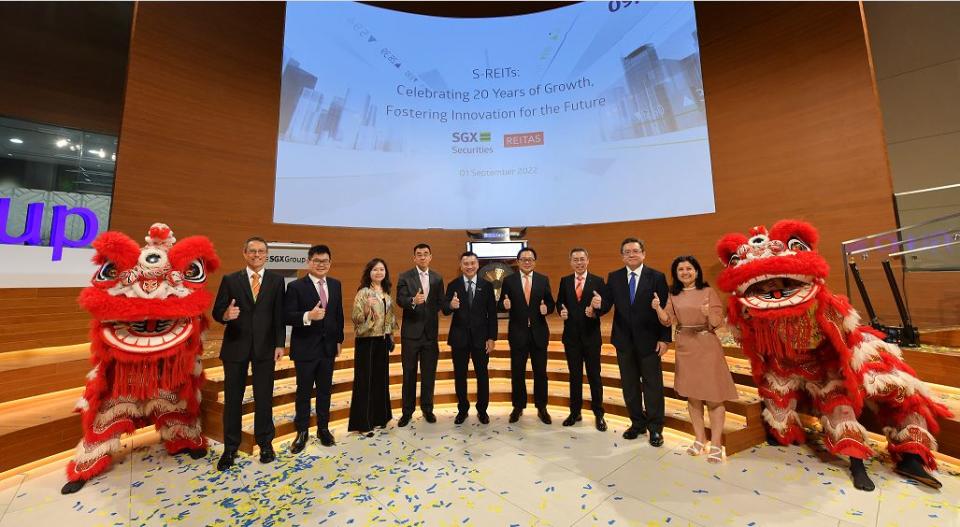Celebrating 20 years of S-REITs

Celebrating 20 years of REITs, REITAS Exco remains optimistic, says we have learnt from crises including Eagle fiasco
To celebrate 20 years of S-REITs, an event organized by REITAS and the Singapore Exchange held on Sept 1 started off with a couple of speeches, first by Loh Boon Chye, CEO, SGX, followed by Low Chee Wah, CEO, Frasers Property Retail, and President of REITAS. A lion dance, photo taking and camaraderie among sponsors, REIT managers, investment bankers and industry participants rounded off the celebration.
During a media briefing after the ceremony with some members of the executive committee (Exco) of REITAS, Low says he believes that S-REITs will be able to weather the current bout of interest rate hikes and inflation. “There are headwinds now but the REIT market has weathered these headwinds before. We had SARS (in 2003), the Global Financial Crisis (2008-2009), and Covid. Over this period, the REIT sector has continued to be resilient. As long as REITs remain well-capitalised, we should be able to see through whatever bumps that are facing us,” Low says.
Jonathan Quek, Co-Head of Asean Banking, Capital Markets and Advisory, Co-Head of Asia Pacific Real Estate and Lodging, Citigroup Global Markets Singapore, and vice-president of REITAS, points out that S-REITs punch above their weight.
“REITs [in Asia] raise U$10 billion to U$12 billion of capital a year. S-REIT account for 40%-50% of that and that is quite phenomenal. We’ve observed there has been a tremendous amount of resilient built into this market. Singapore is the second-best REIT performing market because of a diverse investor base,” Quek says referring to regional funds that invest in S-REITs.
When asked what are the lessons learnt from the Eagle Hospitality Trust debacle, Quek says “In every market this is a tough question that faces regulators. You can be very restricted. We have found a good balance here. Unfortunately, you will get bad actors in any market place. It was an unfortunate situation. I would think the sector has learnt lessons from that. When you have a bad sponsor coming in and trying to do something like that you can’t prevent it.”
Should sponsors’ financials be included in the IPOs given the challenges we have faced with these overseas sponsors? Low points out that it is the assets that are being offered to the public. “So you look at the track record and cash flow of the asset. We’ve seen some [unknown] sponsors tie up with others to give more credibility in the REIT marketplace.”
Quek says the assets need to stand by themselves as the market is buying into the assets. “You’ve got to make a distinction [between the sponsor and the assets]. And there are now enhanced disclosure requirements."
In general, the Exco felt that a three-year financial record of the sponsor in an IPO prospectus was a step too far as it isn’t the sponsor that is listing.
The S-REIT sector has been successful mainly due to its external manager model where the sponsors are strong, support their REITs with pipeline and, more importantly, funding and liquidity when needed. Hence, they are able to trade at lower yields commanding lower cost of capital, making it easier to acquire. Moreover, these sponsors keep their best assets for their REITs. Together, the CapitaLand and Mapletree REITs account for more than 50% of S-REIT market capitalization, and also for the outperformance of the S-REITs, where the total returns of their REITs in the last 10 years have recorded double digit CAGRs.
Is there room for other structures? Should mid-sized, unknown overseas sponsors be asked to list an internally managed REIT instead of the current external model? Apparently, regulators are agnostic as to whether REITs are internally or externally managed. However, in the attempt at IPOs, these would-be internally managed REITs were unable to garner sufficient cornerstone investors and investor interest to ‘cover the book’ so to speak.
“In the US, REITs are internally managed because investors in the US place a very heavy discount on externally managed REITs because of corporate governance concerns,” Quek notes.
Is that the reason why US REITs listed on SGX trade at yields of 8% to 9%? “The S-REIT structure has been proven by delivery of returns and we don’t get a lot of questions on internally or externally managed REITs. Investors have accepted the S-REIT model. It’s down to asset quality, sponsor support. Besides, Digital Core REIT trades at 4%-5% yield,” Quek replies referring to the latest S-REIT with US assets.
Ronald Tan, Vice President, Equity Global Market, Global Sales & Origination, SGX and Honorary Exco Member of REITAS Exco says: “My dream is for any global sponsor to say, ‘if I am going to list a REIT, the jurisdiction will be Singapore.”
He is hopeful that S-REIT managers will be even more astute in capital management, the SGX will be a launchpad for new asset classes, and SGX will be able to attract best-in-class sponsors. The two REITs that listed in Dec 2021 – Daiwa House Logistics Trust and Digital Core REIT have gone some way to fulfil Tan’s dream.
See Also:
Click here to stay updated with the Latest Business & Investment News in Singapore
CGS-CIMB maintains 'buy' call on Lendlease REIT, but cuts target price and DPU forcasts
Prime US REIT reports 1HFY2022 distribution of 3.52 US cents per unit
‘Stronger growth pipeline’ for KIT, Basslink troubles behind it: DBS
Get in-depth insights from our expert contributors, and dive into financial and economic trends

 Yahoo Finance
Yahoo Finance 